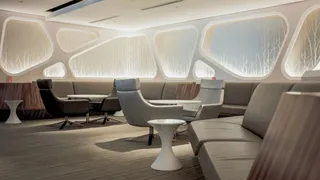We are delighted to welcome neuroarchitect Fiona Beenkens as a speaker at the Superyacht Design Festival 2026. Beenkens is the founder of BetterAtHome and an architect specialising in neuroarchitecture, bringing a unique expertise at the intersection of design and neuroscience. Her work explores how spaces can directly influence the brain, behaviour and overall quality of life.
Beyond her architectural practice, Fiona is a writer, podcaster and an international and TEDx speaker. As a trainer, she has guided hundreds of architects and designers worldwide in integrating the principles of neuroarchitecture into their work. Ahead of the conference, BOAT's Lucy Dunn spoke to her about her work.
What first drew you to neuroarchitecture, and how did you become interested in it?
I always knew I wanted to be an architect. After five years of studying, I burned out from stress and turned to meditation, which completely changed how I felt. That experience led me to explore the subconscious mind - and over time, I started seeing clear links between mindfulness and architecture.
Can you explain what neuroarchitecture is?
Neuroarchitecture explores how our brains and bodies respond to the spaces around us. It looks at how design elements – light, colour, acoustics and spatial layout – influence our nervous system and emotions.
One key aspect involves understanding our brainwave states. For example, the alpha state is calm and restorative, the beta state is alert and focused, while gamma is triggered by high stress or danger. Ideally, we should move naturally between these states during the day, but our surroundings can help or hinder that.
In open-plan offices, for instance, the subconscious mind stays alert to movement, noise and people walking behind us, making it harder to reach that relaxed alpha state. The same happens when you work with your back to a door or sleep without seeing the entrance – the brain never fully disconnects because it feels unsafe. These effects can actually be measured through brain activity scans, showing how directly our environments shape our mental states.
Does nature come into this?
Absolutely. While neuroarchitecture is still emerging, biophilic design – bringing nature into buildings – has been researched for decades and is very much an element of neuroarchitecture. We know that our nervous system calms when exposed to natural views, greenery or sunlight. That’s why so many hospitals now incorporate gardens and outdoor views.
It’s logical when you think about it: walking through a forest feels completely different from walking through a shopping mall. The goal is to bring that sense of calm indoors.
However, many companies mistake biophilic design for wellbeing. Adding a green wall or a few plants isn’t enough if the overall layout keeps people in a constant state of alert – with black ceilings, red walls and open spaces where no one feels protected. Without addressing those deeper factors, nature becomes a superficial gesture rather than a truly neuro-informed design.
Did you study neuroarchitecture formally?
No – when I first became interested, it was still a very new concept. I wanted to write my thesis on it, but it was rejected because it wasn’t recognised as a formal field at the time. So, I started researching on my own, speaking with neuroscientists like Steven Laureys to find scientific grounding for what I was observing.
Right now, you can’t “become” a neuroarchitect – it’s not a qualification, but a way of approaching architecture and integrating neuroscience into the design process.
Are there measurable differences in how people experience neuro-informed spaces?
A neuro-informed space doesn’t erase stress, but it doesn’t amplify it either. If you’ve had a difficult day and you’re in an environment that prevents your nervous system from calming down, that stress will build. The same goes for colour – a red meeting room, for instance, won’t cause tension, but if tension already exists, red can intensify it.
What are the basic principles of neuroarchitecture?
In my TEDx talk, I describe three main principles: organising space differently, using colour differently and giving equal importance to aesthetics and wellbeing. Aesthetics matter as much as how a space makes us feel – it’s never one or the other. Our brains are wired for safety and control. Even children instinctively choose corners or seats with a view of the room, avoiding places where something could approach from behind. Yet many modern offices are designed without any protected areas, keeping our brains in a constant state of subtle alertness.
It’s not about removing windows or starting from scratch – it’s about creating with intention. You can still have large windows, but perhaps reduce them slightly so there’s space to place a couch against a wall - a small change that gives the brain a sense of grounding and security.
How does this apply to yacht design?
The same principles apply. At sea, you’re in an environment where you can be approached from any direction, so the brain naturally seeks a sense of protection. If a yacht is completely open, surrounded by windows, there’s no refuge – nowhere to feel truly safe. Even in luxurious settings, the brain still craves a sheltered spot that signals: “You’re safe here."
When it comes to colour, perception is also deeply personal and cultural. What feels calming to one person might feel uncomfortable to another. For example, green is often seen as balancing and peaceful, but someone with negative associations from childhood might find it unsettling. In my culture, blue often represents rain and coldness, but in warmer regions, it might evoke the sea and serenity.
The Superyacht Design Festival will return to Kitzbühel on 1-3 February 2026. Tickets are priced at €1,599. Social-only tickets are also available, priced at €1,199. Book now to avoid disappointment!
BUY TICKETS
